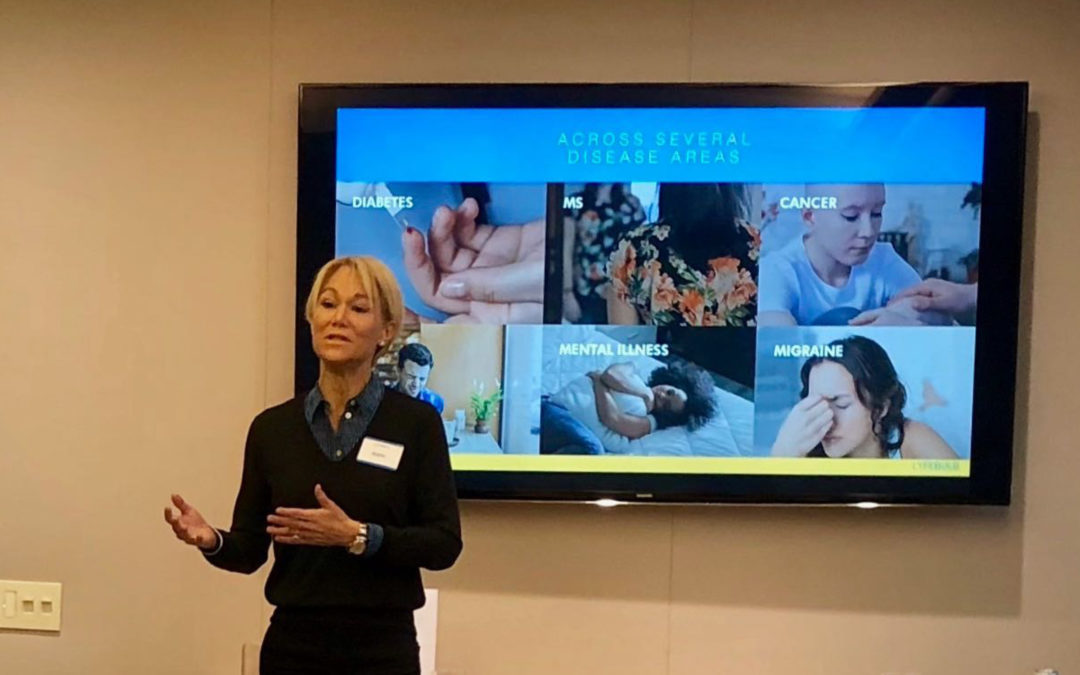With Karin Hehenberger, Founder & CEO of Lyfebulb
Digital acceleration has only intensified during COVID-19. How can the healthcare industry, one that is stretched to its absolute limit, benefit from this? When it comes to treating patients, there’s more to the care of patients than hospital outcomes. In some cases, managing one’s health is a long-term plan. Karin Hehenberger, Founder & CEO of Lyfebulb, shares how as an innovator in helping patients manage their chronic disease, the company is empowering patients to take control of their chronic disease(s) and accelerating their ability to support patients with long-term disease.

The Lyfebulb Team Conducting a Workshop at SACCNY’s collaborative innovation platform, Gateway – Shown left to right: Jamie Haight, Leslie Brille, Karin Hehenberger, Kinza Kasher, Stefanie Hirsch, Katie Rimland.
In the face of the ongoing pandemic, what are the main challenges Lyfebulb has encountered?
During these unprecedented times of COVID-19, patients are confronted with a multitude of issues resulting from increased isolation and lack of access to regular care. Chronic disease patients face the additional burden of trying their best both to manage their disease while in quarantine AND to avoid contracting the virus as they are often more vulnerable. As a chronic disease-focused patient empowerment platform, Lyfebulb connects patients and industry to support user-driven innovation and reduce the burden of chronic disease. Connecting patients to one another, both live & virtually, is at our core. Isolating times like these emphasize the need for more accessible, innovative solutions to enable connectivity and ensure safety for patients and their care partners.
What kind of partnerships do we need today to provide improved patient care? Has your company initiated any industry or cross-sector collaborations?
Lyfebulb currently maintains industry partnerships in mental health (substance use disorder specifically), transplantation, ulcerative colitis & multiple sclerosis to identify areas of unmet need and innovation. Other therapeutic areas where we continue to support and develop a targeted community include diabetes, cancer, migraine, IBD including Crohn’s disease, and mental health including depression and anxiety.
The need for virtual peer-to-peer connectivity and the need for digital products to access care remotely is evident now more than ever.
Lyfebulb has therefore accelerated the launch of LyfeConnect, a digital connectivity platform connecting patients and care partners with one another to provide both a community sharing platform and 1:1 support.
The importance of offering a platform like LyfeConnect to certain chronic disease populations, especially now during COVID, is evident in a transplant. Transplant patients are greatly immunosuppressed and therefore far more vulnerable to viruses like COVID than the average. It is mandatory for transplant patients to fully embrace social distancing measures, and for a much longer time period than those who are less at risk.
Additionally, people struggling with substance use disorders need more help now than ever. Many individuals in recovery rely on in-person meetings in order to stay in recovery and receive community support. Lyfebulb is actively working with a partner to bring digital support and therapeutic treatments into the patients’ homes so everyone struggling with addiction has access to support and treatment resources.
Lyfebulb helps patients manage their long-term diseases. How has social distancing and the demand for professional care affected patient care? Has it affected the demand for Lyfebulb?
Managing their original disease has become more difficult during these times. Many avoid getting labs drawn, and even getting elective but important procedures done due to the risk associated with a hospital visit. Since Lyfebulb is not in the business of medical care, we cannot assist here, but we make it point to discuss options with patients and try to help them make good decisions of when and if they need to seek care.
Your patients are affected by health conditions before the COVID-19 pandemic – even more so now – how have you responded to these effects on the patient?
The healthcare system is overwhelmed by the influx of COVID-related demands, but the unmet needs of chronic disease patients are still ongoing. Therefore, our work alongside patients and care partners to identify pain points and areas of innovation is a much-needed responsive effort. Additionally, social distancing measures and the need to further isolate high-risk patients have led to implementations of new systems in care facilities and hospitals. Transplant recipients have spoken to improvements in blood sample drop-off, implementing protocols to reduce the wait time in the hospitals, and curbside check-ins.
What kind of innovations in social entrepreneurship are needed to “truly change the lives of those living with chronic disease”?
Engaging the individual who is living with the disease serves several purposes toward that goal. It engages the patient or care partner, moving them from a passive recipient of information or care, to an active and empowered individual, ready to take charge. It also aligns with achieving market success with an idea, beyond purely achieving financial success, since patient entrepreneurs* care about being able to use the technologies in real-life. To summarize, integrating the human experience of living with the disease, whether as a patient or care partner, is crucial to any innovative approach’s lasting success in changing lives.
*A patient entrepreneur is an individual who overcomes and manages their chronic disease in an entrepreneurial way.
What kind of major changes do you think we will see on the other side of the pandemic? Any that we would not have considered pre-COVID-19?
Telemedicine and digital therapeutics will outlive this pandemic and become a staple inpatient care going forward. Many brick and mortar clinics and treatment solutions have transitioned to virtual care across therapeutic areas. Fortunately, these organizations pivoted quickly to meet demands, and this does not mean they will revert back once the pandemic ends. There are many positives to telemedicine like increased access and cost reduction that will make this pandemic-related change a lasting one. Some surprises we have seen involve better food choices for some (prepared at home, and not in fast-food restaurants), fewer infections due to social distancing and homeschooling, improved family relations for some (caveat since there has also been an increase in domestic abuse), reduced side effects due to closer obedience of medical treatments, as well as the effect of virtual peer to peer support on medical outcomes. Studies will need to be conducted, but initial data show positive results already.
In the future, how can companies better prepare for a crisis like this? How can the public and private sectors plan for a more coordinated response?
Parts of the world have been operating in a preventative state for years, due to their experience with highly contagious diseases, yet in the U.S., we have not. We can improve going forward. For example, parents have been sending children to school despite them being sick, people are going to work with fevers and colds, travel is totally unmonitored by the health authorities, even though simple measures such as temperature checks, accelerated diagnostics, and contact tracing are feasible with current technology. Restaurants still do not fully respect food allergies well, and educational levels are not high enough across many facilities to keep up good hygiene. We have been living in a pretty “dirty” society, which some may say is okay if one believes in the “hygiene hypothesis” or as it is commonly called in Sweden “lite smuts rensar magen”. However, that also means we were not prepared for a fatal disease such as COVID 19.
The advice to companies going forward includes being nimble and being able to quickly adapt to crises. We have lived through issues before, and those who survive to do it with more experience and new business models as well as new technology as a result.
At Lyfebulb we have always emphasized the need for digital connectivity even before the pandemic. Patients and care partners often feel isolated both due to their limited mobility, the risk for injury as well as due to their feeling of being “different”. In some ways, our patients are better prepared than those who are “healthy” for this sudden change, since they have had to accommodate (often with self-induced isolation) due to their disease many times before.
Lyfebulb is a SACCNY member and impacts lives by providing a platform for those living with chronic diseases. If this company sounds interesting to you, please reach out to the SACCNY team and we can get you connected!


